Who is the blogger?
Archived entry
Little Big Man (1970) and The Searchers (1956)
Dustin Hoffman winds his way through multiple episodes in "Little Big Man" retelling the story of the Wild West from an unconventional point of view as the aged Jack Crabb. John Ford also gives us a slightly different perspective on frontier life through the story of Ethan Edwards in a somewhat surprising twist on the traditional Saturday afternoon John Wayne Western in "The Searchers".
A Fate Worse Than Death
This past week a friend of mine buried her mother and put down her pet dog. She also watched as an elderly man with whom she has worked extensively as a caregiver was shuffled off to a life of greatly diminished independence in an institutional facility in spite of the fact that the man’s mental and physical health did not truly demand such a move at this point. The family had decided that “it was time to put grandpa in a home”. My friend’s mother died after an institutional euthanasia incident of death by starvation. The doctor at the one hospital decided that this was the “only reasonable and humane” course of action given the medical circumstances. Funny. Just two days before the transfer from one hospital to another, the doctors of the oher institution were of a completely different opinion concerning the treatment and outcome for the elderly patient. I guess they just picked the wrong hospital!
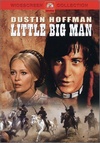 In the movie presented on TVO, “Little Big Man”, Dustin Hoffman stars in the role of the aged Jack Crabb, a wily old coot who claims to tell you what you need to know “about Custer and the way he was and about the Indians and the way they was”. By using this device of sifting the story of the Wild West through the remembered experiences of the ancient Jack Crabb, director Arthur Penn after the novelist Thomas Berger, manages to create a unique point of view on historical events in the American West.
In the movie presented on TVO, “Little Big Man”, Dustin Hoffman stars in the role of the aged Jack Crabb, a wily old coot who claims to tell you what you need to know “about Custer and the way he was and about the Indians and the way they was”. By using this device of sifting the story of the Wild West through the remembered experiences of the ancient Jack Crabb, director Arthur Penn after the novelist Thomas Berger, manages to create a unique point of view on historical events in the American West.
After all, who is going to dispute with the memories and musings of a man who is more than 120 years old? It’s just not something that you do. No. You end up doing what the rather pretentious over-educated historian with his fancy tape recorder does; you just sit down and listen to the ramblings of someone who has lived a very different life. You end up taking in the story just as it spills out of Jack Crabb’s mouth, memories of a very old man who makes no pretence of telling you the whole truth. Jack Crabb only claims to tell you his story as he remembers it, confused and confusing as it is.
The “truth” about matters may be in there somewhere, but this is primarily the story of Jack Crabb. The movie is not about distilling the absolute truth about the way things were in the Wild West. It is about learning something important as you listen to the stories and ruminations of the elders, much as Little Big Man did in those countless encounters with his grandfather, Old Lodge Skins (Chief Dan George).
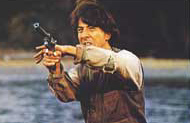 Through this device of telling the tale of an old man’s life remembered, the filmmaker is able to accomplish many things that might not otherwise be possible. A straightforward telling of a revisionist history of the Wild West would hardly have been as palatable. It almost certainly would not have been as memorable. And how else could one manage the excruciating re-examination of questions of conscience concerning the genocide of the American Indians without installing the counterbalance of zany comedy? The comedy, rather than being a mere distraction, somehow allows the mind of the viewer to take in the horrors of the Indian Wars that middle America might otherwise find it convenient to “screen out”.
Through this device of telling the tale of an old man’s life remembered, the filmmaker is able to accomplish many things that might not otherwise be possible. A straightforward telling of a revisionist history of the Wild West would hardly have been as palatable. It almost certainly would not have been as memorable. And how else could one manage the excruciating re-examination of questions of conscience concerning the genocide of the American Indians without installing the counterbalance of zany comedy? The comedy, rather than being a mere distraction, somehow allows the mind of the viewer to take in the horrors of the Indian Wars that middle America might otherwise find it convenient to “screen out”.
The overall effect in my opinion is that the viewer ends up with something that is “truer than the truth”, if that makes any sense. One reviewer that I read made mention of Charles Dickens’ caricatures in his novels. “Little Big Man” does something of the same thing.
Much of what goes on in the film is the presentation in episodic fashion of a series of caricatures. They are portraits painted with sensitivity and liveliness, but caricatures nonetheless. Dickens used these fictitious creations in his popular writings to entice the people of his day (and later students of his works) to examine serious social questions that very much needed examination. Dickens’ initial goals may have been commercial success and the entertainment of the public.
However, in retrospect, one can say that Dickens certainly must have intended what he achieved during his career; influence in the larger arena of social commentary and social activism. The point was that Dickens did not just write to entertain people. There was a part of him that desperately wanted to change the way people looked at things. As a result of changing people’s level of consciousness about certain realities in society, perhaps an author like Dickens hoped that society would one day actually change for the better.
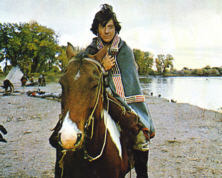 Jack Crabb moves back and forth between the world of the Indian and the white man’s world. He moves from one adventure to another, from one accident of fortune to the next. As he goes, Jack tries on various philosophies of life in much the same way as he changes his outfit to fit his situation. When we leave Jack at the end of the movie, he doesn’t seem to have a handle on things any more than he did at the beginning of the film as a confused 10 year old.
Jack Crabb moves back and forth between the world of the Indian and the white man’s world. He moves from one adventure to another, from one accident of fortune to the next. As he goes, Jack tries on various philosophies of life in much the same way as he changes his outfit to fit his situation. When we leave Jack at the end of the movie, he doesn’t seem to have a handle on things any more than he did at the beginning of the film as a confused 10 year old.
Old Lodge Skins, Jack’s adoptive Indian grandfather, has some wonderful lines near the end of the film. As the elderly Indian gives an eloquent elegy for his own funeral from a spectacular mountain vista, you feel along with Jack that the cycles of life are mysterious and magnificent and that everything on the earth, including mankind, has a place. There is a time to live and a time to die. Old Lodge Skins has said that it was a good day to die. Surely he must know. You fully believe, as the old mystic lies down beside his burial pyre, that Old Lodge Skins is so much in touch with the spiritual realities of life that he can actually decide to die at a given moment. As the rain begins to plop on the grandfather’s closed eyelids, everything does an about face. “Sometimes the magic works, and sometimes it does not,” is all that the unflappable Old Lodge Skins has to say about it as he hobbles down off the mountaintop.
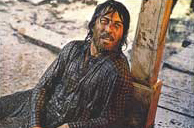 Such events, comical as they may be as a final statement on the life of Jack Crabb seem to support the philosophy of life espoused by the snake oil salesman, Merriweather. The Dustin Hoffman character appears to be battered by life’s meaninglessness, condemned to a fate worse than death. Jack Crabb survives multiple calamities and reversals of fortune without ever being able to quite put it all together.
Such events, comical as they may be as a final statement on the life of Jack Crabb seem to support the philosophy of life espoused by the snake oil salesman, Merriweather. The Dustin Hoffman character appears to be battered by life’s meaninglessness, condemned to a fate worse than death. Jack Crabb survives multiple calamities and reversals of fortune without ever being able to quite put it all together.
Merriweather observes rather wryly about his young protégé, “That old Indian has taught you too well.” But Jack Crabb can neither live nor die as a Cheyenne brave. Neither can he live out his years in the comfort of the white man’s world. He has known too much of the Indian way of life to adapt himself fully to the craziness of the whites who live without knowing where the centre of the world lies. In the end he is an old white man who hasn’t been able to sing a hymn in over a hundred and four years. Now there’s a pity.
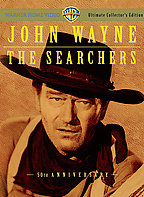 The first feature on Saturday Night at the Movies, “The Searchers” was a classic John Wayne Western. This first film had real entertainment value, although I must admit that I was not looking forward to seeing it again as much as I was looking forward to rewatching “Little Big Man”.
The first feature on Saturday Night at the Movies, “The Searchers” was a classic John Wayne Western. This first film had real entertainment value, although I must admit that I was not looking forward to seeing it again as much as I was looking forward to rewatching “Little Big Man”.
The producers went for a sure-fire combination of the ever popular Western theme, star power in John Wayne, sex appeal with the younger characters of Nathalie Wood and Jeffrey Hunter, and comic relief in Hank Word (as Mose Harper). It seemed to work pretty well.
“The Searchers” does appear to be a bit more complex than many “shoot’em up, hang’em high, rescue the damsel in distress” formula Westerns. It actually does approach some deeper subjects through the classic Western formula. We discover that things are a bit more complex than they at first appear.
John Wayne is a war hero of sorts, but his past is a little more shady and his motives for going on this five year quest are a bit more muddy than we’re used to seeing at the Saturday matinee Western. In fact, when John Wayne finally achieves his goal and comes upon his niece, Debbie, things are so emotionally complex that we are not sure if he is going to shoot her or “rescue” her. Likewise, in traditional Hollywood Westerns, we are not supposed to have any kind of ambiguous feelings about Indians, at least not the kind who raid homesteads and massacre settlers. Things are supposed to be pretty clear-cut and uncomplicated.
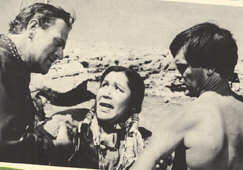 As a latter viewer of the film, my big problem with Cicatrice, the Comanche chief is not that he is potrayed as a real human being, but that he seems to be miscast. Henry Brandon, a capable and hardworking actor of European descent, just did not look or feel to me like a real Indian chief. In your standard Western where you have a whole bunch of guys running around on a back lot dressed up in wigs and grease paint as Indians getting shot at by a whole bunch of other guys dressed up in cowboy suits, it doesn’t really matter so much. But this time, given the rest of the film, I think that it did matter that Cicatrice, the Comanche chief, was just another European dressed up like an Indian.
As a latter viewer of the film, my big problem with Cicatrice, the Comanche chief is not that he is potrayed as a real human being, but that he seems to be miscast. Henry Brandon, a capable and hardworking actor of European descent, just did not look or feel to me like a real Indian chief. In your standard Western where you have a whole bunch of guys running around on a back lot dressed up in wigs and grease paint as Indians getting shot at by a whole bunch of other guys dressed up in cowboy suits, it doesn’t really matter so much. But this time, given the rest of the film, I think that it did matter that Cicatrice, the Comanche chief, was just another European dressed up like an Indian.
One thing where John Ford really did get it right was the ending. John Wayne stands framed in the doorway at the end of the film in an iconic moment. This is a Western with a difference. The film begins and ends with this 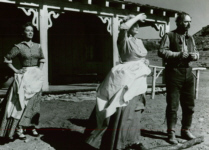 doorway. The lone gunman does not go riding off into the sunset, off to his next heroic adventure. He hesitates in the shadow of a doorway. What is Ethan Edwards supposed to be thinking about at that moment? What was “the fate worse than death” after all? What is Ethan Edward’s place in civilized white society? Are we so civilized after all? Is this man a hero to be admired or an obsessive maniac to be pitied and eschewed?
doorway. The lone gunman does not go riding off into the sunset, off to his next heroic adventure. He hesitates in the shadow of a doorway. What is Ethan Edwards supposed to be thinking about at that moment? What was “the fate worse than death” after all? What is Ethan Edward’s place in civilized white society? Are we so civilized after all? Is this man a hero to be admired or an obsessive maniac to be pitied and eschewed?
Now before we get too deep into all of this social analysis stuff, let’s remember that this is John Wayne and it is a John Ford film in the mid-fifties. And it is, above all, a classic Western. Bring on the popcorn!
Suggested Reading:
- IMDb Trivia: Two additional motives are hinted at for Ethan Edwards unending passion for revenge buried in the film “The Searchers” – watch the graveyard scene.
- How could he do it? Selling out to the “white man’s religion”.
- Another look at the “Big Story”
- Dealing with putting a loved one in a home.
- Communicating positively with aging parents
- A fate worse than death: a personal story of facing up to Lou Gehrig’s disease
- Tough questions: euthanasia from more than a dramatic angle. Includes a look at Eastwood’s “Million Dollar Baby”
- Have you thought about it lately? Who's directing your life?



